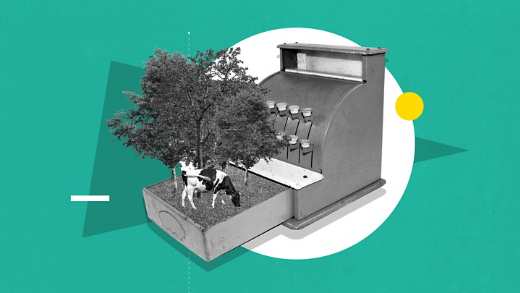New technologies that would once have seemed the stuff of science fiction fantasy are quickly becoming reality; in the process transforming cities and creating investment opportunities.
Tower 42 was the City of London’s first skyscraper. Plans for the building, formerly known as the Natwest Tower, were first unveiled in 1964 but the prospect of such an edifice piercing London’s skyline proved so controversial that the foundations were not laid until 1970 and construction took a further 10 years.
Many won’t bother to learn to drive or own a car but will simply rely on Uber-like apps to get from A to B. Those who do own cars will regard them chiefly as a means of earning money, either by feeding energy back in the grid at times of peak demand or by renting them out.
Today, the City’s gleaming pillars of enterprise shoot upwards at an astonishing pace and have proliferated in such numbers that anyone returning after a few years’ absence would be amazed by the change. A time traveller from 50 years ago, when bowler hats and pinstripes were commonplace and St Paul’s Cathedral had only recently been supplanted as London’s tallest building, would think they were in an alien land.
If anything, the pace of change is likely to quicken. However, we have a good idea of how cities of the future will look because many of the transformational technologies that will influence their development are already in use.
Self-driving and electrical vehicles (EVs), for example, are likely to have a major impact and will transform city dwellers’ attitude to cars. Rather than being status symbols, cars will be commoditised.
“Many won’t bother to learn to drive or own a car but will simply rely on Uber-like apps to get from A to B. Those who do own cars will regard them chiefly as a means of earning money, either by feeding energy back in the grid at times of peak demand or by renting them out,” says Isaac Vaz, associate director, infrastructure equity at Aviva Investors.
If Vaz is right, this trend will have significant implications for the way cities look. Parking spaces, car parks and petrol stations could disappear; to be replaced by green recreational areas, housing and shops. The air should be far cleaner as the petrol engine is phased out and wind and solar energy power tomorrow’s world.
Singapore is among the global leaders in the drive towards smart city status and has launched initiatives across various areas, including energy efficiency and water usage, health and transport.
Thousands of sensors in some neighbourhoods monitor energy and water usage as well as waste production in individual apartments. Residents are provided with feedback that can help them use less water and energy, and so save money. Meanwhile, the same data should enable the authorities to improve the planning, design and maintenance of public housing estates.
To improve the efficiency of the city state’s roads, the government is calling for satellite-navigation systems to be installed in all vehicles. These will supply data to show exactly where every car is as at any given time across the island, allowing for better traffic management.1
Elsewhere, some African countries have ambitious plans to develop smart cities, reflecting the rapid pace of urbanisation expected in the coming decades. Kenya, for example, has already begun building a $9 billion new “silicon” city called Konza, located south of Nairobi and heavily-influenced by existing new cities such as Cyberjaya in Malaysia and Cyber City in Mauritius.2
Stepping ahead
The smart cities of the future could incorporate novel ways of generating power. These include capturing the kinetic energy from footsteps. This may sound futuristic, but the technology has already been developed by Pavegen of the UK. One footstep generates around five watts of electrical power, according to the company.3
“Tiles could be placed in Bank Station using the energy from tens of thousands of marching commuters to power street lighting,” says Vaz.
Moreover, the footfall data produced by the “smart streets” in which the tiles are installed can provide significant insights into consumer behaviour in shopping centres, for example. “Retailers could use this intelligence to gauge the effectiveness of advertising or maximise the efficient use of signage to influence where people go,” adds Vaz.
In a similar vein, electrical vehicles could be charged as they drive around the city’s streets. Qualcomm, the US semiconductor and telecommunications multinational, has already demonstrated the technology at a test track in Versailles, France.4 As with Pavegen’s technology, these roads will produce an immense amount of “Big Data” that could prove useful in a myriad of ways, including the development of self-driving cars.
Vaz acknowledges there are some drawbacks, not least the cost and inconvenience of installing charging systems under roads. However, there are many advantages too.
“Dynamically-charged cars could theoretically run forever, meaning batteries could be smaller and lighter, and cars could be cheaper to run. Users would not need to regularly plug in their cars, eliminating the need for hundreds of thousands of charging points in Europe alone,” Vaz adds.
The BIM effect
While it may take years before these technological wonders become commonplace, cities are already being designed and built in a completely different manner from just 10 years ago. Planners, architects and investors no longer need to pore over rolls of complex blueprints but can use virtual reality created by laser scanning to see how the final building will look.
They can also watch construction develop in 3D with accompanying data, and projections of when the building will be completed and its final cost, thanks to Building Information Modelling (BIM), which produces a digital representation of a construction project.
BIM helps eliminate errors, sometimes only discovered once construction is underway; speeds up the building process; cuts construction and operational costs; shows how a project should perform when built; and helps manage the building far more optimally than is the case today, says Dan Bentley, a partner at construction and property consultancy Core Five.
Expanding on this, Lee Coates, BIM manager at Core Five, believes BIM “has effectively modernised the construction industry and is providing a significant increase in efficiency”.
It can also de-risk a project, according to Bentley. “BIM coordinates the different disciplines that supply services to a building, such as architects, structural and electrical engineers,” he says. “This ’clash detection‘ could be done previously but was time consuming and subject to human error, while contractors would add a premium to take on the cost of any risk, inflating the overall cost of a project.”

Indeed, the potential for cost savings is so great that the UK government now requires BIM be used in any public sector-funded project as a means of reducing capital costs by 20 per cent.5
Coates believe the government’s initiative is helping to make the UK a global leader in the application of BIM. “The UK has produced a series of documents relating to BIM to provide a standardised framework, whereas other countries have adopted a piecemeal approach,” he says. “Indeed, the UK’s documents are expected to become an international standard for BIM adoption on projects.”
Sandra Reis, BIM manager at construction and engineering firm Costain, concurs with that view; explaining that the UK and northern European countries have generally been much quicker to adopt BIM than their southern counterparts.
Developments in Singapore have also impressed Reis. While BIM is usually applied to individual buildings, the city state has even greater ambitions. The government’s “Smart Nation” initiative aims to model the entire city in 3D.
Meanwhile, BIM is being used to change the face of other Asian cities. The Shanghai Tower, China’s tallest building, uses BIM to control everything from energy use to fire alarms.
Vaz believes the use of BIM brings significant advantages throughout a building’s lifecycle, including at the design phase. “If you are planning a new underground line or a new building in a city such as London, you inevitably have to take account of the position of existing infrastructure on the ‘as built’ drawings,” he says. “These are the original design drawings, which have been revised to reflect any changes made in the field. Yet often they are not updated, so a building may actually be 10 metres to the left of where it is supposed to be, a deviation that can have a major impact on where a new development should be sited.”
By contrast, BIM provides an accurate guide designers and architects can use for new projects. BIM also shows how the building will behave over time; allowing further adjustments to be made that could improve its sustainability.
Vaz cites the £4 billion-plus Thames Tideway Tunnel as an example of how BIM can save money during the construction process. The tunnel, a ‘super sewer’ built under the tidal section of the River Thames, will stop sewage overflowing into the river. To create the tunnel, a large amount of soil must be removed by barge. Timing when the barges can dock is critical given the tide moves by around two metres. Vaz says that BIM allows the planners to know exactly when the barges should arrive, boosting efficiency and avoiding project delays.
Operational efficiencies
Managing projects in an efficient manner can also bring considerable economic and environmental savings. Indeed, the operational phase of a building is the main contributor to a building’s lifecycle cost, according to the British Institute of Facilities Management, while the lifecycle cost is estimated to be three times that of the construction cost.6
The combined heat and power company ENER-G estimates that “by having historical design data instantly available, up to 15 per cent can be saved on maintenance time and sometimes may remove the need for costly site visits”.7
The construction industry has a well-established reputation for being resistant to change and being less efficient in terms of its processes when compared with, for example, the manufacturing and aerospace industries, says Coates. Nonetheless, he believes BIM will become increasingly widespread and the norm for many projects in the next five years.
Eye in the sky
New technology is also changing the way asset management firms monitor their investments in physical assets, such as infrastructure and commercial property. Vaz points to the increasing use of drones as an example.
“Most of our asset managers are based in London, but we are invested in projects all over the country,” he says. “Drones with cameras can provide a wealth of information that could only otherwise be accessed by flying in one of our managers. So we can use drones to check how the construction of a project is developing, comparing real-time images with the construction plans. We could use a drone to check for rust on turbines, or, by analysing a heat map captured by the drone, determine whether panels in a solar park are operating efficiently.”
According to Vaz, drones could also help cities use energy more efficiently by creating heat maps that show where energy is being wasted and where it is most needed.
“If we can find a way of connecting the two, capturing waste heat and transferring it to areas of high energy demand, the boost to energy efficiency would be considerable,” he says.
Escape from the country
In 2016, an estimated 54.5 per cent of the world’s population lived in urban settlements, according to the UN. It projects that by 2030 urban areas will house 60 per cent of people8, which means over a billion more people will be living in cities than today.
Consequently, the development of smart cities that can deliver environmental and quality of life benefits could make a major contribution to human progress and well being. Moreover, just as new technology allows us to see what a future building will look like; we can already model the outlines of the cities of the future.
References
1 'Singapore is striving to be the world’s first `smart city’’, endgadget, March 2016
2 'Kenya begins construction of ‘silicon’ city Konza', BBC News Online, January 2013
3 'The next big thing in energy might be people power', Bloomberg, August 2017
4 'Qualcomm demonstrates dynamic electric vehicle charging’, Qualcomm, May 2017
5 'How does BIM benefit facilities managers?’, Service Works Group, January 2018
6 'BIM case studies for asset and facilities management’, British Institute of Facilities Management, September 2015
7 'How Building Information Modeling (BIM) can improve future energy consumption’, energ-group, June 2016
8 'The world’s cities in 2016’, United Nations, 2016

















